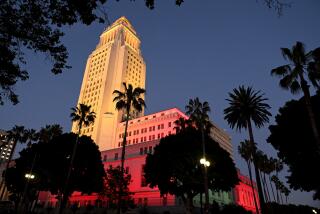Move to Increase City Council Size Deadlocks Panel
In a debate in which the issue of ethnic representation took center stage, the Los Angeles Elected Charter Reform Commission deadlocked Saturday on whether to increase the size of the 15-member City Council, which black and Latino members argued was likely to reduce their overall representation.
The heated contention over proposals to enlarge the City Council underscored how the dynamic demographic shifts sweeping America’s second-largest city are playing an integral role in the jockeying over who will wield power here in the 21st century.
“The discussion of the size of the City Council is inevitably tied to perceptions over which groups are likely to be helped and which groups are likely to be hurt,” said Erwin Chemerinsky, chairman of the commission. “The problem, however, is we’re drawing the charter not just for the demographics of 1998, but hopefully one that will last the next 70 years.”
The commission ultimately voted 10 to 3 to table the issue and said it would be reconsidered sometime in the future after a task force delivers a proposal on the creation of neighborhood councils.
The commission postponed the matter of City Council size after it failed to produce an eight-vote majority on any of a series of previous motions, including one for a 25-member council, and another that would allow voters to choose between the current 15 and 25, or between 15 and 19.
Ultimately, whatever the commission recommends will go before the voters, along with its entire charter reform package, in April or June. A separate, appointed commission--which favors 21 City Council seats--will make its proposals to the council, which will decide which of them appear on the ballot.
Woody Fleming, a black member of the elected commission, characterized the deadlock as a victory for those who oppose a substantive council increase.
“Latinos and African Americans came together on 15,” Fleming said. “We have to do coalition-building. We can get further down the political road if we walk together.
“We’ve already had two riots,” he added. “If this city is going to come together, we have to look at areas with greater need.”
However, a motion to definitively maintain the 15-seat status quo also died.
“Right now we’re evenly divided between those who want 15 and those who want 25,” said Chemerinsky.
A business group’s proposal for a 35-member council was rejected by a 13-0 vote of the commission, but its proponents said they believe they can win more support for their plan by adjusting their map of proposed districts with input from Latino leaders concerned about its impact on Latino representation.
“Our map should not be interpreted as a rigid map,” said Matt Klink, a member of the Los Angeles Business Advisors. “These are tentative decisions, and they will all be revisited in the future.”
Currently there are three black and three Latino members on the council, meaning the two groups represent 40% of the council members.
“What we would maintain is that no matter how you draw the lines, if you increase council seats, diversity will diminish,” said Anthony Chavez of the Mexican-American Legal Defense and Educational Fund.
Another big issue was the cost to taxpayers. Some asked how the current council could leap to 35 seats without a huge budget increase. Some have suggested salary cuts. Los Angeles City Council members earn $107,000--the most in the country--compared to $70,500 in New York City.
Looming over the debate is the bid by the San Fernando Valley for secession, which was prompted by frustrations over representation and quality of city services.
Similar frustrations are erupting in other outlying areas, like the port community of San Pedro.
In fact, there is no other city in America where council members represent as many citizens. Each council member must serve about 245,000 citizens, compared to 143,000 in New York.
“We’ve heard from all over the city that people want to increase the City Council and have greater representation,” said Geoffrey Garfield, the administrative director of the commission. “Now it’s just in limbo. The lobbying of special interests on both sides have created a deadlock.”
To activists from smaller communities who favor neighborhood councils with decision-making powers, the issue underscored their contention that local communities, not council members, should attend to crucial local issues.
“People want trees trimmed and potholes fixed, not, quite frankly, more politicians or a more powerful mayor,” said Julie Butcher, a city employees union leader who supports neighborhood councils. “We want more empowered communities.”
More to Read
Sign up for Essential California
The most important California stories and recommendations in your inbox every morning.
You may occasionally receive promotional content from the Los Angeles Times.










